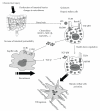Toll-like receptor signaling and liver fibrosis
- PMID: 20706677
- PMCID: PMC2913673
- DOI: 10.1155/2010/192543
Toll-like receptor signaling and liver fibrosis
Abstract
Liver fibrosis occurs as a wound-healing scar response following acute and chronic liver inflammation including alcoholic liver disease, non-alcoholic steatohepatitis, hepatitis B and C, and autoimmune hepatitis. Myofibroblasts, mainly transdifferentiated from hepatic stellate cells, are pivotal cell types that produce fibrillar collagen. The activation of inflammatory cells, including Kupffer cells, is a crucial step for activating hepatic stellate cells. Toll-like receptors (TLRs) are pattern recognition receptors that sense pathogen-associated molecular patterns (PAMPs), which discriminate the products of microorganisms from the host. TLRs are expressed on Kupffer cells, endothelial cells, dendritic cells, biliary epithelial cells, hepatic stellate cells, and hepatocytes in the liver. TLR signaling induces potent innate immune responses in these cell types. The liver is constantly exposed to PAMPs, such as LPS and bacterial DNA through bacterial translocation because there is a unique anatomical link, the portal vein system between liver and intestine. Recent evidence demonstrates the role of TLRs in the activation of hepatic immune cells and stellate cells during liver fibrosis. Moreover, crosstalk between TLR4 signaling and TGF-beta signaling in hepatic stellate cells has been reported. This paper highlights the role of TLR signaling in stellate cell activation and the progression of liver fibrosis.
Figures


Similar articles
-
Role of innate immunity and the microbiota in liver fibrosis: crosstalk between the liver and gut.J Physiol. 2012 Feb 1;590(3):447-58. doi: 10.1113/jphysiol.2011.219691. Epub 2011 Nov 28. J Physiol. 2012. PMID: 22124143 Free PMC article. Review.
-
Cooperation of liver cells in health and disease.Adv Anat Embryol Cell Biol. 2001;161:III-XIII, 1-151. doi: 10.1007/978-3-642-56553-3. Adv Anat Embryol Cell Biol. 2001. PMID: 11729749 Review.
-
Toll-like receptors in liver fibrosis: cellular crosstalk and mechanisms.Front Physiol. 2012 May 22;3:138. doi: 10.3389/fphys.2012.00138. eCollection 2012. Front Physiol. 2012. PMID: 22661952 Free PMC article.
-
Decoding cell death signals in liver inflammation.J Hepatol. 2013 Sep;59(3):583-94. doi: 10.1016/j.jhep.2013.03.033. Epub 2013 Apr 6. J Hepatol. 2013. PMID: 23567086 Review.
-
Role of toll-like receptors in immune activation and tolerance in the liver.Front Immunol. 2014 May 16;5:221. doi: 10.3389/fimmu.2014.00221. eCollection 2014. Front Immunol. 2014. PMID: 24904576 Free PMC article. Review.
Cited by
-
The pathological appearance of hyaline droplets in Kupffer cells is not specific to patients with autoimmune hepatitis.Int J Clin Exp Pathol. 2017 Aug 1;10(8):8703-8708. eCollection 2017. Int J Clin Exp Pathol. 2017. PMID: 31966728 Free PMC article.
-
Chronic Toll-like receptor 4 stimulation in skin induces inflammation, macrophage activation, transforming growth factor beta signature gene expression, and fibrosis.Arthritis Res Ther. 2014 Jul 1;16(4):R136. doi: 10.1186/ar4598. Arthritis Res Ther. 2014. PMID: 24984848 Free PMC article.
-
The Role of NADPH Oxidases (NOXs) in Liver Fibrosis and the Activation of Myofibroblasts.Front Physiol. 2016 Feb 2;7:17. doi: 10.3389/fphys.2016.00017. eCollection 2016. Front Physiol. 2016. PMID: 26869935 Free PMC article. Review.
-
Central role of the TIR-domain-containing adaptor-inducing interferon-β (TRIF) adaptor protein in murine sterile liver injury.Hepatology. 2017 Apr;65(4):1336-1351. doi: 10.1002/hep.29078. Epub 2017 Mar 3. Hepatology. 2017. PMID: 28120431 Free PMC article.
-
The oral microbiome in autoimmune diseases: friend or foe?J Transl Med. 2023 Mar 22;21(1):211. doi: 10.1186/s12967-023-03995-x. J Transl Med. 2023. PMID: 36949458 Free PMC article. Review.
References
-
- Lin R-S, Lee F-Y, Lee S-D, et al. Endotoxemia in patients with chronic liver diseases: relationship to severity of liver diseases, presence of esophageal varices, and hyperdynamic circulation. Journal of Hepatology. 1995;22(2):165–172. - PubMed
-
- Chan CC, Hwang SJ, Lee FY, et al. Prognostic value of plasma endotoxin levels in patients with cirrhosis. Scandinavian Journal of Gastroenterology. 1997;32(9):942–946. - PubMed
-
- Takeda K, Akira S. Toll-like receptors in innate immunity. International Immunology. 2005;17(1):1–14. - PubMed
LinkOut - more resources
Full Text Sources
Other Literature Sources

